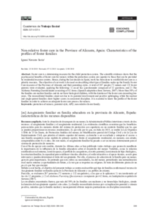Displaying 821 - 830 of 2214
As part of a broader action research project aiming to prevent both harmful sexual behaviour carried out by children and young people and child sexual exploitation (CSE) in out‐of‐home care, four focus groups were undertaken with 17 workers at three Victorian residential houses in 2017.
This study synthetic cohort life tables and data from the Adoption and Foster Care Analysis and Reporting System to generate the first cumulative prevalence estimates of termination of parental rights.
Drawing on the extant literature, this chapter will present a multileveled discussion of the experiences of prejudice and bias foster youth face, with a focus on the systemic inequities among diverse youth in foster care, the individual challenges youth with different social identities face, socialization processes that can support these youth, and challenges foster parents face in supporting foster youths’ healthy identity development.
This paper considers the importance of material objects for looked after and adopted children integrated as part of life story work practices.
This study examined the possible differences in educational level by comparing Finnish national register data for 814 former reform school (RS) residents in four cohorts (placed in out-of-home care in 1991, 1996, 2001 and 2006) to 4021 of their peers in the general population matched by gender, age, and place of birth.
The present study uses the US National Youth in Transition Database (NYTD) to examine educational attainment, employment, homelessness, and incarceration for white, African-American, Hispanic, and American Indian/Alaska Native emancipated youth.
This chapter from Former Foster Youth in Postsecondary Education focuses on the transition point when youth begin to age out of care and may move into postsecondary education.
This chapter will help the reader to understand the design and outcomes of the foster care system in the USA.
This poster, presented at the Annual Meeting of the Belgian Association for Psychological Sciences, provides an overview of a study on foster children's sense of belonging.
This article describes what type of families make up the Family Foster Care resource of the Province of Alicante and their parenting styles.


